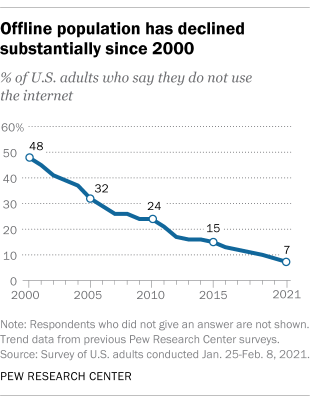For many Americans, going online is an important way to connect with friends and family, shop, get news and search for information. Yet today, 7% of U.S. adults say they do not use the internet, according to a Pew Research Center survey conducted Jan. 25-Feb. 8, 2021.
Pew Research Center regularly studies technology adoption among U.S. adults. This analysis focuses on the rates of internet adoption among Americans based on a survey of 1,502 U.S. adults conducted Jan. 25-Feb. 8, 2021, by cellphone and landline phone. The survey is weighted to be representative of the U.S. adult population by gender, race, ethnicity, age, household income, education and community type. Here are the questions, responses and methodology used for this report.
Internet non-adoption is linked to a number of demographic variables, but is strongly connected to age – with older Americans continuing to be one of the least likely groups to use the internet. Today, 25% of adults ages 65 and older report never going online, compared with much smaller shares of adults under the age of 65.
Educational attainment and household income are also indicators of a person’s likelihood to be offline. Some 14% of adults with a high school education or less do not use the internet, but that share falls as the level of educational attainment increases. Adults living in households earning less than $30,000 a year are far more likely than those whose annual household income is $75,000 or more to report not using the internet (14% vs. 1%).
There are no statistically significant differences in non-internet use by gender, race and ethnicity, or community type.
Despite some groups having persistently lower rates of internet adoption, the vast majority of Americans are now online, as ongoing government and social service programs encourage internet adoption in underserved areas. Over time, the nation’s offline population has been shrinking, and for some groups that change has been especially dramatic. For example, 86% of adults ages 65 and older did not go online in 2000; today that figure has fallen to just a quarter.
The share of offline adults ages 50 to 64 has dropped 8 percentage points since 2019, from 12% to 4%. The shares of offline Black and Hispanic adults have also fallen significantly during that period, from 15% to 9% among those who are Black and from 14% to 5% among those who are Hispanic.
Note: Here are the questions, responses and methodology used for this report. This is an update of a post originally published July 18, 2015.



